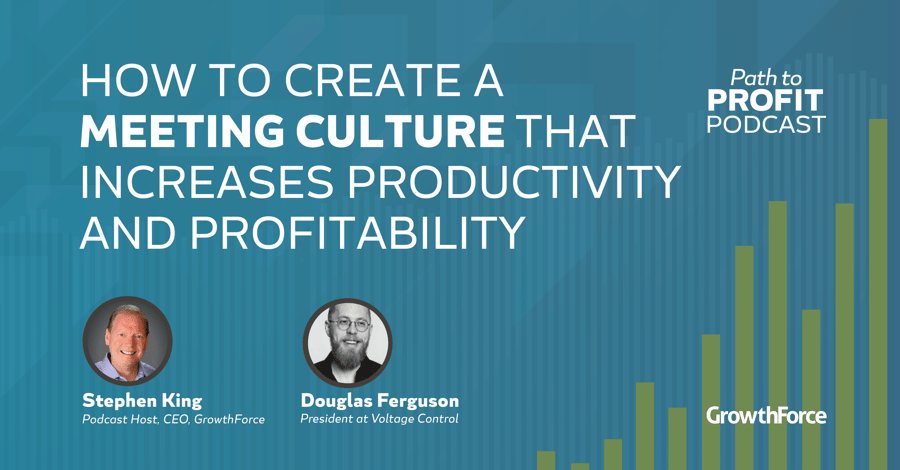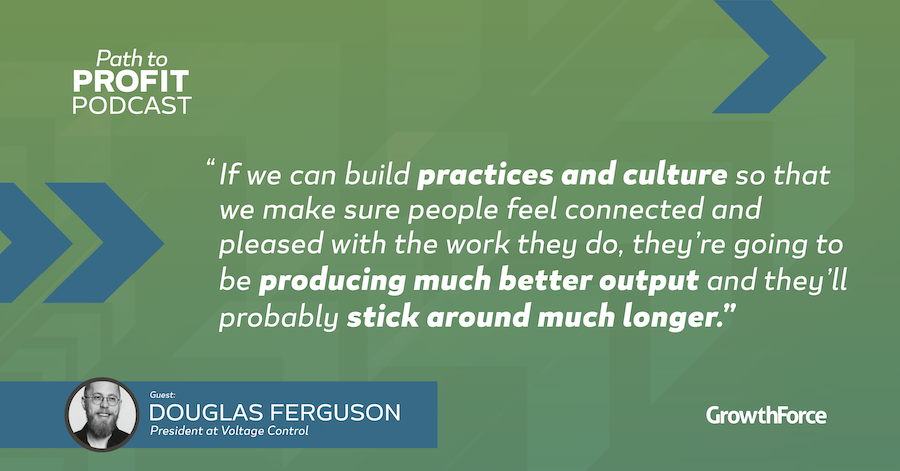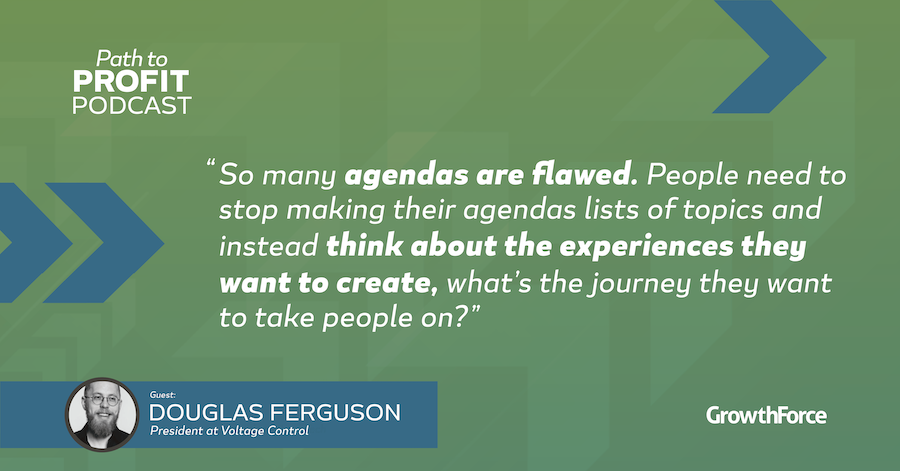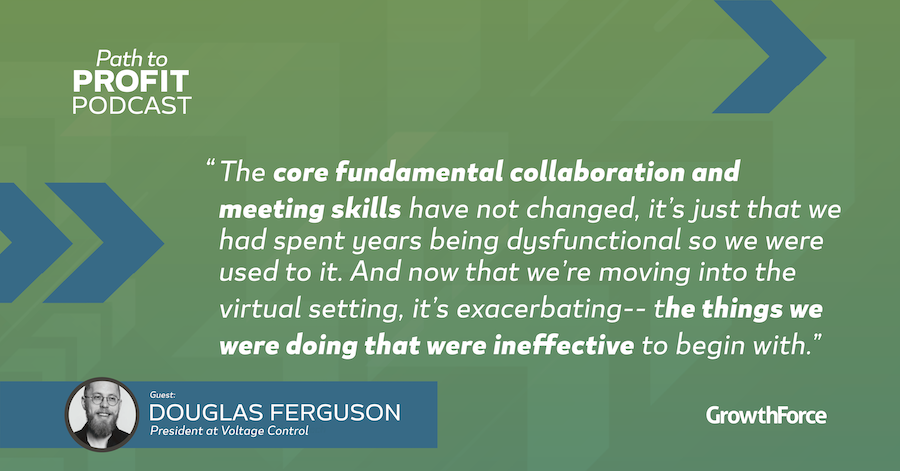7 min read

We've all been in meetings where no one contributes, no one takes anything away, and everyone leaves feeling a little less vibrant, having been drained of time and energy. This type of meeting is costly- and your bottom line takes the hit.
|
Key Takeaways
|
It not only wastes resources during the meeting but has the potential to negatively affect productivity after the meeting has been adjourned.
In service businesses and nonprofits, your largest expense is your labor costs. With that in mind, the single most expensive thing you're ever going to do in any business is have more meetings.
As a business leader, you must take intentional steps to ensure that every minute of every meeting is used wisely so that you get the biggest ROI out of the resources you spend on meetings as you can.
To better understand how we can all avoid the dreaded, worst-case scenario meeting, GrowthForce CEO spoke with Douglas Ferguson, who is the president and founder of Voltage Control and co-author of several books, including Magical Meetings: Reinvent How Your Team Works Together.
In this Path to Profit episode, they discussed how business leaders can adjust the way they approach meetings – virtually or in-person – to improve productivity and profitability.
🎧Listen to the full episode here!
How Virtual Meetings Exposed Existing Problems
As workplaces were forced to shift from meeting in person to meeting virtually in 2020, many of Ferguson's clients began calling on his company frantically looking for resources to improve their virtual meetings.
They requested facilitation and training resources to help everyone transition more smoothly into the remote workplace.
"We put some stuff together, and, you know, the irony of it is the training's not much different than the training we did for facilitation of meetings prior to the pandemic," Ferguson remarked. "We're just now using virtual tools to deliver it."
So, if meeting virtually doesn't truly differ much from meeting in person, what caused the panic?
"Ultimately the core fundamental collaboration and meeting skills have not changed," explained Ferguson. "It's just that we had spent years and years being dysfunctional. So, we were used to it."
The past year, everyone rushed into a virtual setting that felt foreign and different with no opportunity to transition gradually. That unfamiliarity simply exacerbated inefficiencies that already existed long before the pandemic happened.
These problems were then more greatly compounded by the immediate absence of opportunities to build social connections and maintain workplace culture via the serendipitous conversations that happen in person. In an attempt to replace the watercooler conversations, calendars began filling up with even more ineffective meetings.
"The important thing is to step back and think about your meeting culture and how you design it," added Ferguson.
How to Design a Better Meeting Culture
To build a better meeting culture (both virtually, and, as more people are back into the office, in-person), there are several things to consider, such as:
- The types of meetings that are important
- When you want to meet
- How you want to meet or what virtual tool you use to meet
To start, take an inventory of past meetings to determine what kinds of meetings you're currently having, look at which ones are working, which ones really aren't working, and think about how you can fix the terrible ones.

Set Meeting Expectations
Start by scheduling a purpose so that each meeting begins with intention. Beginning meetings by asking everyone to quietly write down what they think the intention or purpose of the meeting is so that they don't influence each other's answers.
"Then they all share out," Ferguson added, "and that's an amazing way to diagnose lack of alignment because people wrote vastly different things."
Then you know that they came in with different expectations, and when you realize that's happening, you can fix it. Before the next meeting, you'll communicate the meeting's purpose more clearly and then people can opt-out if they know they won't make a difference attending – if they know they won't add anything or take anything away.
Do the Work in the Meeting
Traditional meetings end with action items, but Ferguson advised against this in favor of doing the work in the meeting. He suggests designing meetings so that you and your team can actually collaborate and work together. Collaborative tools like Google Documents, Mural, Figma, or OneNote allow everyone to be in, taking notes at the same time which facilitates real-time feedback to improve alignment.
"If we just talk about stuff and then say, 'Alright what's the action item,' Jill is going to go do this. Jill goes and does it. Then we look at it a week later and say, 'Oh, that's not what we meant.'" Ferguson remarked.
When everyone's reacting to and reshaping a rough draft of meeting notes in real-time, the post-meeting follow-up or commitments are building upon a collaborative foundation that everyone has already agreed on instead of the things everyone thought they'd agreed on.
By doing the work in the meeting, your team will save time and energy. Additionally, this type of real-time collaboration saves everyone from the negative feelings that arise as a result of wasted work that occurs due to miscommunication and poorly designed workflows.

Appoint Multiple Scribes
Appoint multiple meeting attendees as scribes (i.e. note-takers) during the meeting. This helps add richness to meeting notes because the notes will be filtered through each scribe's unique perspective.
This practice also aligns with the meeting takeaways because the meeting facilitator will notice when people write down slightly different things. You can then pause the meeting to clarify.
As King put it, “collaborative meetings notes offer a shared vision and shared ownership.”
Foster Psychological Safety
With more and more work getting done remotely and meetings happening in a virtual arena, business leaders are more concerned than ever about maintaining their workplace culture – and this is a valid and very serious concern because a good or bad workplace culture can make or break a business.
Not only does positive workplace culture reduce employee turnover rates and drive productivity, but Ferguson found it also creates a more ideal environment for learning.
"Positive is a growth mindset," he said. Ferguson also explained that negativity can inspire fear and doubt, triggering a protection mechanism in the brain. "There's a lot of brain science behind what makes for good learning states," Ferguson added.
When it comes to brain chemistry, growth mindset, positivity, and opportunity are all much better for learning states because the brain is bathed in chemicals that are more conducive to learning.
Ferguson explained that creating a psychologically safe meeting environment and workplace culture creates the type of environment that's best for learning, growth, and productivity. To cultivate psychological safety in the workplace, adopting a growth mindset is essential.
Having a growth mindset means being open to new ideas and perspectives, hearing criticism without reacting negatively, expecting failure, and viewing failure as an opportunity for improvement. Additionally, when practicing a growth mindset you should focus on past success and identify what worked and how it can be repeated.
In meetings, you can also help create a more joyous, caring, compassionate, and connected environment by spending the first five minutes checking in with everyone. This is an opportunity to replace the watercooler talk with quick personal updates that keep everyone connected to the human side of their coworkers.

Better ROI on Your Investment in Meetings
Meetings are arguably one of the most expensive overhead costs in an organization. Having unproductive meetings has an alarming effect on your bottom line. In fact, a recent survey observing 19 million meetings found that ineffective meetings cost up to $399 billion in the US. [1]
So, the million (or billion) dollar question- how do you see a better ROI from your meetings? It starts with making sure you have a standardized process of monitoring and measuring performance.
It’s impossible to know the true ROI of your meetings without measuring employee behavior. You should notice a spike in productivity. If your meetings clearly enhance the way people work together, you’re on the right track. [2]
Whether you've resumed meeting in person or are still facilitating virtual meetings, you can take advantage of Ferguson's advice to improve workplace culture, see a better ROI on the time and resources spent in meetings, and watch your productivity and profitability soar.
[1] https://blog.otter.ai/meeting-statistics/
[2]https://leadmeetings.com/blog/productive-meetings-roi/




